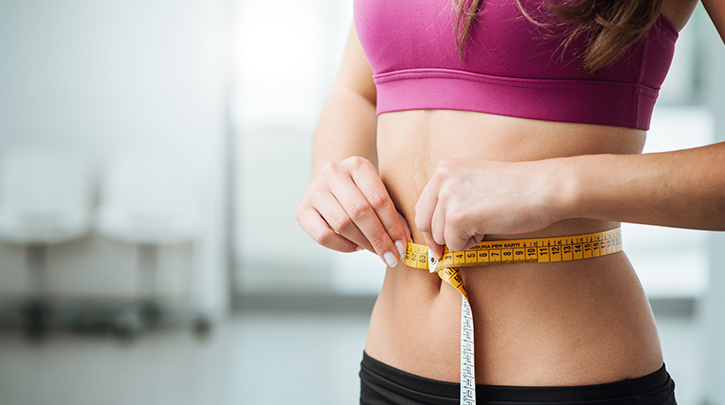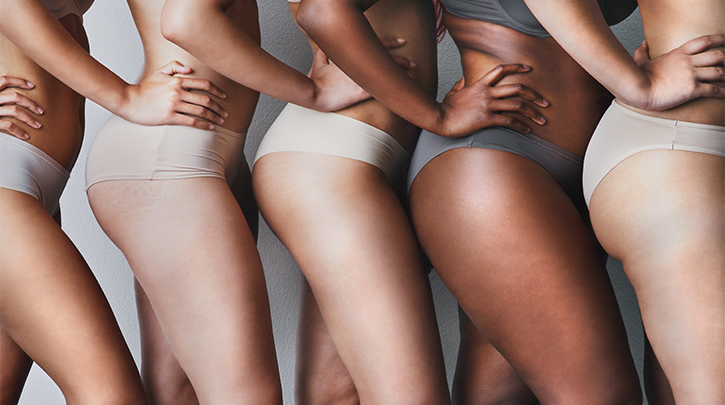

Why is it so tough to lose or even manage your weight? Weight gain, loss, and maintenance requires a complex balance between not just fat and muscle, but six different types of body fats. With calorie counting added to this long list, weight loss can be more than just a little daunting. Make your path to weight loss success a little simpler with this guide that’ll help you break down the basic facts to weight management based on fat types.
The six top types of body fat include essential fat, brown fat, white fat, beige fat, subcutaneous fat, and visceral fat. While there may be varying ways to approach the categorization of body fat, it’s easiest to consider what’s predominantly good and bad for your overall health. For the most part, a healthy balance between most of these fats should be the target.
Good or bad? Very good
What is it? The most aptly named fat type, essential fat is required for good health. It plays a role in regulating body temperature, vitamin absorption, and the production of fertility hormones, among other essential roles. Essential fat isn’t highly visible, but is located throughout the body.
How do I manage it? Essential fat is “good” fat, meaning this isn’t the type you’ll target for weight loss. For females, 10-12% essential fat is the general range for good health, with 2-4% being the ideal range for men, according to the American Council on Exercise. Essential fat loss is generally the result of extreme and unhealthy exercising and dieting.
Good or bad? Good
What is it? Brown fat burns energy and is primarily responsible for maintaining the body’s core temperature. Because brown fat isn’t a storage fat, it’s easy to burn, especially in cooler climates.
How do I manage it? You don’t really need to manage brown fat aside from maintaining essential fat levels to support healthy brown fat production.
Good or bad? Kind of good, kind of bad
What is it? White fat is the body’s largest energy storage system. Due to its production of the hormone adiponectin, white fat is essential for insulin management to maintain a healthy blood sugar balance and, as a producer of leptin, it also helps to manage hunger. White fat also plays a role in managing growth hormones and cortisol. While white fat can be a good thing, too much of it becomes a bad thing. In greater levels, white fat can cause insulin resistance, raising the risk for weight gain and its accompanying health concerns.
How do I manage it? Stubborn excess fat on the thighs, hips, and abdomen are a key sign of higher white fat levels. Target training workouts that build muscle tissue, which burns more calories than fat, can help to reduce white fat levels in the body. Also, a study in the journal Cell suggests that paying closer attention to your body’s hunger cues (i.e. eating more consistently and stopping when you feel satisfied rather than uncomfortably full) can encourage the transition of white fat to brown fat.
Good or bad? Good
What is it? Beige fat is created when the body is exposed to stress, leading to the “beiging” of white fat. While a high level of beige fat isn’t really a target goal, it’s definitely a step in the right direction to maintain healthy levels of good brown fat; it essentially allows for the transformation and burning of bad fat as thermal energy to maintain the body’s core temperature.
How do I manage it? Beige fat’s role in transforming white fat to useful thermal energy makes it a good target fat for weight loss. Exercise is considered a key stressor for transforming white fat to beige fat due to the production of the hormone irisin. The key here is stress, so aim for at least 75 minutes of vigorous exercise each week and favor high-intensity interval training to increase irisin levels that prompt the “beiging” of white fat.
Good or bad? Good and bad
What is it? Located just under the skin, subcutaneous fat accounts for approximately 90% of overall body fat percentage. Commonly accumulating as stubborn thigh fat in females or around the abdomen in males, subcutaneous fat is responsible for the sex hormone estrogen. Because estrogen plays a larger role in female fertility, females tend to have higher levels of subcutaneous fat. This fat type also acts as a cushion between muscle and skin tissue for protection and comfort.
How do I manage it? Subcutaneous fat is essential but too much, particularly around the abdomen, runs the risk of increased health complications. Because the body stores subcutaneous fat as a sort of emergency backup in case of starvation or caloric deprivation, this type of fat is the hardest to target. A reduction in calories consumed, a focus on improved nutrition to avoid refined carbs and processed foods, and regular high-intensity exercise can, over time, burn off excess subcutaneous fat. Alternatively, for more stubborn fat pockets, radio frequency-based body shaping treatments, when combined with a healthy diet and regular exercise, may further help to target and shrink fat cells for quicker, more visible results.
Good or bad? Bad
What is it? Visceral fat is found in the abdominal area between organs. It accumulates and secretes retinol-binding protein 4, a known culprit in insulin resistance. Higher levels of visceral fat are also linked to an increased risk of colorectal and breast cancers, dementia, stroke, and Alzheimer’s disease. Visceral fat levels generally increase with age.
How do I manage it? One of the best ways to minimize visceral fat levels is to revamp your diet. Cut out processed foods and increase your intake of lean proteins (chicken, eggs, beans), unsaturated fatty foods (fish, nuts, avocados), whole grains, and fiber (beans, berries, oatmeal). Improving sleep hygiene will also offer fat-burning benefits, with seven to nine hours of sleep being the general target. Additionally, targeted abdominal strength-training exercises will increase caloric burn and help melt away visceral fat as compared to cardio.
Cellulite isn’t just fat. It is a result of subcutaneous fat accumulation alongside the breakdown of fascia, the connective tissue located beneath skin’s surface that keeps skin appearing smooth and muscles and other internal organs in place. Essentially, fascia is like a webbing of collagen and elastic fibers that stretch and bend with muscles. When fascia breaks down, which is common especially among women, the muscle pushes subcutaneous fat up and through the weak spots in the fascia, leading to cellulite’s typical lumps and bumps.
How can you beat cellulite? While there are ways to temporarily and instantly mask cellulite, a long-term treatment needs to have the following three basic factors to be successful:
Some topical treatments may help target fat cells below the skin’s surface, but they miss out on collagen stimulation. For a more effective approach that hits the mark on all three factors, consider radio frequency-based cellulite reduction treatments. Delivering energy via an advanced multi-polar applicator, these treatments generate consistent and targeted heat below the skin’s surface to shrink fat cells while boosting circulation and collagen production.
To target stubborn pockets of fat around the abdomen and flanks to help you better achieve your body goals, opt for a non-surgical alternative that uses clinically proven technology to reduce fat. Venus Bliss™ fat treatments are powered by diode laser technology to break down stubborn fat cells in a comfortable manner. Treatments require no downtime and is safe for all skin types.
Interested in learning more about how cellulite reduction and fat treatments may be the perfect complement to your weight loss diet and workout routine? Contact a certified treatment provider near you today using the search field below.
Find a certified treatment provider near you.



Search below to find a provider near you and to learn about our non-surgicial treatments with ARTAS®, NeoGraft®, Venus Bliss™, Venus Versa™, Venus Legacy™, Venus Velocity™, Venus Viva™, Venus Freeze Plus™, Venus Glow™, and Venus Heal™.
For more information call: +27 31 535 7241 // [email protected] // Liberty Life Building, 21 Aurora Drive, Umhlanga Ridge Durban, 4301, South Africa
REGULATORY CLEARANCES [ More ]
Venus Versa™ has CE Mark as a multi-application device intended to be used in aesthetic and cosmetic procedures. The SR515 and SR580 applicators have CE Mark for the treatment of benign pigmented epidermal and cutaneous lesions and treatment of benign cutaneous vascular lesions. The HR650/HR650XL and HR690/HR690XL applicators have CE Mark for the removal of unwanted hair and to effect stable long-term or permanent hair reduction for Fitzpatrick skin types I-IV. The AC Dual applicator has CE Mark for the treatment of acne vulgaris. The DiamondPolar™ applicator has CE Mark for non-invasive treatment of moderate to severe facial wrinkles and rhytides on females with Fitzpatrick skin types I-IV. The OctiPolar™ applicator on the Venus Versa™ system has CE Mark for temporary body contouring via skin tightening, circumferential reduction, and cellulite reduction. The NanoFractional RF™ (Viva) applicator has CE Mark for dermatological procedures requiring ablation and resurfacing of the skin.
NeoGraft® 2.0 has CE Mark with indication for use in suction-assisted follicular extraction and re-implantation for males and females.
Venus Epileve™ has CE Mark for hair removal, permanent hair reduction (defined as the long-term stable reduction in the number of hairs re-growing when measured at 6, 9 and 12 months after the completion of a treatment regimen), and the treatment of pseudofolliculitis barbae for all Fitzpatrick skin types. Venus Epileve™ is also CE-Marked for hirsutism.
Venus Legacy™ has CE Mark for the temporary increase of skin tightening, circumferential reduction, cellulite reduction, and wrinkle reduction.
Venus Velocity™ has CE Mark for hair removal, permanent hair reduction (defined as the long-term stable reduction in the number of hairs re-growing when measured at 6, 9 and 12 months after the completion of a treatment regimen), and the treatment of pseudofolliculitis barbae for all Fitzpatrick skin types.
Venus Viva™ has CE Mark for the use in dermatologic and general surgical procedures requiring ablation and resurfacing of the skin, and the treatment of moderate to severe facial wrinkles and rhytides in Fitzpatrick skin types I-IV with the DiamondPolar™ applicator.
Venus Freeze Plus™ has CE Mark for treatment of moderate to severe facial wrinkles and rhytides using the DiamondPolar™ applicator, and CE Mark for the treatment of cellulite reduction, increase of skin tightening, and temporary circumferential reduction on the OctiPolar™ applicator.
Venus Freeze™ has CE Mark for treatment of moderate to severe facial wrinkles and rhytides using the DiamondPolar™ applicator, and CE Mark for the treatment of cellulite reduction, increase of skin tightening, and temporary circumferential reduction on the OctiPolar™ applicator.
Venus Glow™ provides a dermal rejuvenation treatment that works to open up and deep-clean pores. Venus Concept is the exclusive distributor for Venus Glow™.
Copyright © 2025 Venus Concept. All rights reserved.
You are entering our website. For other country/regions and language options, please click the button below.
Click HereAre you a physician or aesthetician? Please visit our medical and aesthetic professional website to learn more.
Click Here